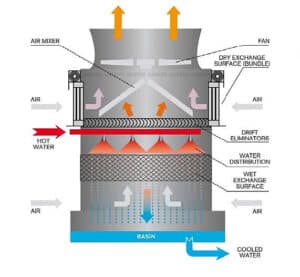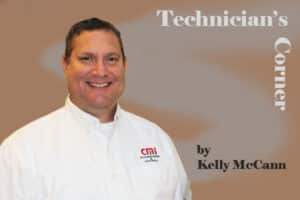Earlier this year we discussed heat pump systems. In this month’s article we will talk about Water Source Heat Pumps and the role water plays in these systems. As mentioned in previous articles, heat pumps operate like straight cooling systems; however, they can reverse cycle to allow the condenser and evaporators to switch functions, allowing the indoor coil to discharge heat in the heating mode. The way water source heat pump differs from the air cooled is that the condenser coil uses water to remove the heat. Water is about 15 times better at removing heat from metal surface than air. This is accomplished by using a specific type of condensing coil. This condenser is a loop in a loop coil allowing counterflow in two separate tubes. The inner tube moves refrigerant in one direction while the outer tube moves water in the opposite direction. This is where the heat is transferred from the refrigerant to the water. The water then travels  back to a heat exchanger to transfer heat to the cooling tower. Water source heat pumps can be either split systems or packaged units. Heat removal is typically water processed through a cooling tower; although, in some instances this water can come from canals, lakes or a well. Cooling towers can range in size from small residential to large industrial. Cooling towers are used for other applications besides HVAC as well since water is a very good medium. Additionally cooling towers are combined with chilled water systems. In this article we are introducing the basic cooling tower and heat pump model. The “usual” set up is a cooling tower is connected to a plate heat exchanger via electrical pump(s). This is known as the open loop; since the tower itself is open to the atmosphere where water can and will evaporate. For this reason, the tower will have an automatic fill to keep the basin at a good working level of water; additionally, since only “water” evaporates, everything else in the water remains behind as scale or sediment. Both are maintenance items: keep the fill valve operating reliably and treat the water to reduce the amount of scale in the basin / fill free of debris and sediment. Warm water is cooled by the cooling tower fan and the cooled water goes back to the plate & frame heat exchanger. Meanwhile, also in the plate exchanger is another circuit. This circuit is the closed loop as its sealed from the atmosphere. This loop carries water from the exchanger to the individual heat pump coils where it picks up the heat. The water then travels back to the plate heat exchanger to have the heat removed and carried back to the cooling tower via the open loop circuit. Water is moved by pump(s) and balanced by circuit setter or manual valves located in the water lines at each heat pump. A control system is typically installed to monitor cooling tower supply and return water temperatures; condensing water supply and return water temperatures as well as water pressure. These values are used to cycle the cooling tower fan as needed, manage additional pumps as needed by temperature setpoints. It should be noted here that I’ve seen some “value engineered” systems that greatly reduce cost by removing some of these items. There are systems in some homes that don’t have a plate heat exchanger and use the water directly from the cooling tower straight to the individual heat pumps. Remember what I mentioned earlier, the cooling tower water is exposed to the atmosphere, which means it will carry outside air and debris with it. This has the potential of causing the heat pump condensing loops coils to become contaminated. Combine this with rust and any scale in the water and the heat pump condensing coils will lose the ability to transfer heat. This is an important aspect of troubleshooting on these systems. Most of the WSHP system is diagnosed the same as its straight cooling counterpart; however, we should learn the water aspect to be effective. Start by measuring the “in” water line to the “out” water line temperature (condensing
back to a heat exchanger to transfer heat to the cooling tower. Water source heat pumps can be either split systems or packaged units. Heat removal is typically water processed through a cooling tower; although, in some instances this water can come from canals, lakes or a well. Cooling towers can range in size from small residential to large industrial. Cooling towers are used for other applications besides HVAC as well since water is a very good medium. Additionally cooling towers are combined with chilled water systems. In this article we are introducing the basic cooling tower and heat pump model. The “usual” set up is a cooling tower is connected to a plate heat exchanger via electrical pump(s). This is known as the open loop; since the tower itself is open to the atmosphere where water can and will evaporate. For this reason, the tower will have an automatic fill to keep the basin at a good working level of water; additionally, since only “water” evaporates, everything else in the water remains behind as scale or sediment. Both are maintenance items: keep the fill valve operating reliably and treat the water to reduce the amount of scale in the basin / fill free of debris and sediment. Warm water is cooled by the cooling tower fan and the cooled water goes back to the plate & frame heat exchanger. Meanwhile, also in the plate exchanger is another circuit. This circuit is the closed loop as its sealed from the atmosphere. This loop carries water from the exchanger to the individual heat pump coils where it picks up the heat. The water then travels back to the plate heat exchanger to have the heat removed and carried back to the cooling tower via the open loop circuit. Water is moved by pump(s) and balanced by circuit setter or manual valves located in the water lines at each heat pump. A control system is typically installed to monitor cooling tower supply and return water temperatures; condensing water supply and return water temperatures as well as water pressure. These values are used to cycle the cooling tower fan as needed, manage additional pumps as needed by temperature setpoints. It should be noted here that I’ve seen some “value engineered” systems that greatly reduce cost by removing some of these items. There are systems in some homes that don’t have a plate heat exchanger and use the water directly from the cooling tower straight to the individual heat pumps. Remember what I mentioned earlier, the cooling tower water is exposed to the atmosphere, which means it will carry outside air and debris with it. This has the potential of causing the heat pump condensing loops coils to become contaminated. Combine this with rust and any scale in the water and the heat pump condensing coils will lose the ability to transfer heat. This is an important aspect of troubleshooting on these systems. Most of the WSHP system is diagnosed the same as its straight cooling counterpart; however, we should learn the water aspect to be effective. Start by measuring the “in” water line to the “out” water line temperature (condensing  water supply and condensing water return), there should be around a 10°F separation. Depending on the type of system you’re working with this number can vary. If your temperatures are “off,” look at two things, the coil itself may be corrupted with scale or rust affecting the heat transfer, these coils can be cleaned or replaced as determined by the diagnosing technician. Another consideration, the cooling tower is not removing the heat from the water. This second aspect could be either the plate heat exchanger or the cooling tower is not transferring heat. Digging deeper into this, we would check the pumps to ensure they are moving water and look for air in the system causing a “vapor lock” or air bubble keeping water from moving through the system. Many cooling tower water systems will have air bleeds installed near the highest points in the water line to purge air from the system. We can consider some of these when diagnosing a cooling tower and plate heat exchanger. At the cooling tower we are generally looking for ≈15°F between in and out water (this number will vary). Inside the tower we want to be careful, especially if the water is not clean or treated, wear proper PPE. Check the water nozzles for good water flow, the fan belt and motor for proper airflow, check the fill for contaminants and the water basin for debris preventing good water flow out of the tower. Plate heat exchangers should be cleaned on a regular basis, when they have contaminants build up inside the heat transfer is affected. I’ve seen some plate exchangers out there that have never been opened or cleaned. A word of caution, don’t attempt to open a plate heat exchanger without training. It’s not difficult but you will want to put them back together correctly to prevent performance issues or leaks.
water supply and condensing water return), there should be around a 10°F separation. Depending on the type of system you’re working with this number can vary. If your temperatures are “off,” look at two things, the coil itself may be corrupted with scale or rust affecting the heat transfer, these coils can be cleaned or replaced as determined by the diagnosing technician. Another consideration, the cooling tower is not removing the heat from the water. This second aspect could be either the plate heat exchanger or the cooling tower is not transferring heat. Digging deeper into this, we would check the pumps to ensure they are moving water and look for air in the system causing a “vapor lock” or air bubble keeping water from moving through the system. Many cooling tower water systems will have air bleeds installed near the highest points in the water line to purge air from the system. We can consider some of these when diagnosing a cooling tower and plate heat exchanger. At the cooling tower we are generally looking for ≈15°F between in and out water (this number will vary). Inside the tower we want to be careful, especially if the water is not clean or treated, wear proper PPE. Check the water nozzles for good water flow, the fan belt and motor for proper airflow, check the fill for contaminants and the water basin for debris preventing good water flow out of the tower. Plate heat exchangers should be cleaned on a regular basis, when they have contaminants build up inside the heat transfer is affected. I’ve seen some plate exchangers out there that have never been opened or cleaned. A word of caution, don’t attempt to open a plate heat exchanger without training. It’s not difficult but you will want to put them back together correctly to prevent performance issues or leaks.
I believe it’s important to note, this is a broad explanation for this type of system. There are more components and controls to discuss as well as water treatment systems that should be added to both the open and closed loop water lines. We will also see VFD’s added for the pumps and tower motors; in some instances, a noise filter for VFD’s in those areas with questionable power supply. We can break these down into individual explanations and diagnostic procedures in another article. The idea for this article is to introduce this information to those who are unfamiliar with water source systems. When working with cooling towers, especially those where the water is not treated, wearing a respirator and proper PPE is recommended.
Kelly McCann is an accomplished Heating, Ventilation and Air Conditioning (HVAC) professional with over 30 years in the industry. He has experience in several capacities; installation, service, service management, O.E.M technical support and territory management. Kelly has also provided professional instruction since 2000, teaching at the Florida Air Conditioning Apprenticeship Association. His current position is Retail Sales Manager at Custom Mechanical Inc. in West Palm Beach, FL.








